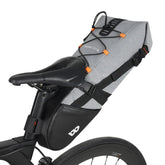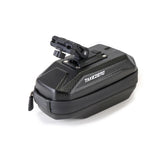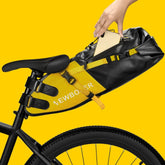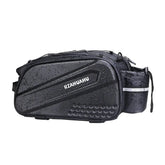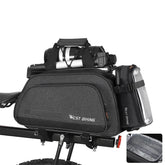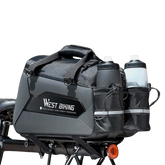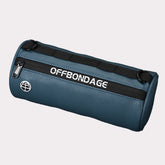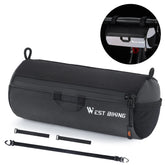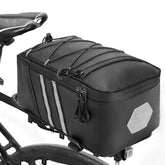-
Upgrade your cycling experience with our versatile saddle bag, designed for ultimate convenience and safety. This ultralight and compact bag offers ample storage while ensuring you're prepared for any ride, day or night. 1.2L Capacity: Perfect for carrying essential items like bike lights, tire...
- From $29.99
- From $29.99
- Unit price
- per
-
BK Blue With Light
-
BK Gray With Light
-
BK Green With Light
-
Black Blue
-
This vibrant and youthful saddle bag is designed to stand out with its colorful reflective material, ensuring visibility and safety during both day and night rides. Constructed from durable polyester and PVC/PU diamond reflective material, the bag is lightweight, weighing only 176g including the...
- $39.99
- $39.99
- Unit price
- per
More sizes available-
Fluorescent Green
-
Pink
-
Adjustable & Foldable Design This saddle bag offers a maximum capacity of 10L, ideal for holding tools and essentials. The roll-top closure allows you to adjust the bag’s length, accommodating varying storage needs. Waterproof & Easy to Clean Made from innovative waterproof material, this...
- $41.99
- $41.99
- Unit price
- per
-
about 10L
-
Enhanced Night Safety Equipped with a reflective logo, this saddle bag improves visibility and safety during low-light conditions, ensuring you remain seen on the road. Universal Saddle Compatibility Designed to fit a variety of saddle types, this bag adapts easily to different bikes, providing...
- $30.99
- $30.99
- Unit price
- per
-
black
-
Easy Unpacking Structure The saddle bag features an easy unpacking structure, providing hassle-free access to your gear and making it convenient for on-the-go cyclists. Reflective Safety Logo Equipped with a reflective logo, this saddle bag enhances visibility and safety during nighttime rides, ensuring you...
- $32.99
- $32.99
- Unit price
- per
-
black
-
Secure Four-Point Velcro Attachment The saddle bag is equipped with four Velcro straps that secure it to the bike seat post at four points. This triangular attachment system ensures exceptional stability and firmness, even on bumpy rides. Spacious and Organized Storage The bag offers...
- $41.99
- $41.99
- Unit price
- per
-
X21557-Advanced
-
100% Waterproof Protection Crafted from premium PVC material, this saddle bag offers full waterproof performance, safeguarding your essentials from rain, dirt, and dust. Its durable and easy-to-clean design makes it a reliable companion for all your cycling adventures. Also the combination of an outer...
- From $40.99
- From $40.99
- Unit price
- per
-
BAG040BLA 13L
-
BAG026 10L
-
BAG040GRE 13L
-
BAG040BY 13L
-
Product Specifications Type: Tail Bag Material: Premium PU Leather + Durable EVA Function: Waterproof and Rainproof Design Color: Sleek Black with Textured Carbon Fiber Finish Size: 38.5 x 19.5 x 16 cm Capacity: Approximately 10 Liters Weight: 676g Special Features Hard Shell Construction Protects...
- $49.99
- $49.99
- Unit price
- per
More sizes available-
Black
-
Enhance your cycling experience with our 10L rear seat bag designed for both functionality and durability. Crafted from high-quality polyester fabric, this pannier bag is ideal for long-distance rides and versatile use. Key Features: Large Capacity: With a generous 10-liter capacity, this bag offers...
- $53.99
- $53.99
- Unit price
- per
-
Black
-
Versatile Double-Sided Rear Bag This bike pannier bag offers a spacious 25L capacity when expanded, making it perfect for both daily commutes and longer cycling trips. The compact 13L size before expansion ensures it remains lightweight and manageable when not fully loaded. Durable &...
- $94.00
- $94.00
- Unit price
- per
-
308 Classic BK-YE
-
323 Upgraded Black
-
308 Classic Black
-
308 Classic Yellow
-
Versatile Functionality Designed for cyclists on all types of bikes—whether road, mountain, folding, or electric—this multifunctional handlebar bag offers practicality with its sleek black design and adaptable utility. Perfect for every cycling adventure. Durable & Weather-Resistant Crafted from premium-grade fabric, this bag is both...
- $28.99
- $28.99
- Unit price
- per
-
Sparkling Gold
-
Vibrant Orange
-
Jewel Blue
-
OF-YTB
-
Enhance your cycling experience with our 1L handlebar bag designed for functionality and safety. Made from high-gloss reflective fabric, this bag offers both practical storage and increased visibility. Key Features: High Gloss Reflective Material: Features a reflective logo and fabric for improved visibility and...
- $29.99
- $29.99
- Unit price
- per
-
black
-
Secure and Spacious Storage for Every Ride Experience the convenience of the Waterproof Bike Frame Bag with Touch Screen Phone Holder, designed for cyclists who demand both functionality and style. With a generous 1.8L capacity and compatibility for smartphones up to 7.2 inches, this...
- From $28.99
- From $28.99
- Unit price
- per
-
Spacious 8L Capacity This bicycle rear seat bag offers an 8L main compartment, providing ample space for your essentials. The additional zipper pocket and adjustable bungee cord help keep your items organized, making it perfect for long rides. Waterproof and Durable Crafted from high-quality...
- $34.99
- $34.99
- Unit price
- per
-
BAG030
-
Rainproof and Durable Design Our 3L bike triangle bag is crafted from waterproof leather with an alloy zipper, ensuring your belongings stay dry in wet conditions. The carbon fiber leather adds extra durability, making it ideal for everyday cycling. Lightweight and Spacious Weighing just...
- $28.99
- $28.99
- Unit price
- per
-
black
FAQs
What types of bike bags are available?
Bike bags are of five major types: Frame bags fit into top tube (0.5-4L), triangle bags fit into triangle space (1.5-10L), handlebar bags are fitted onto front bars (1-8L), saddle bags are fitted under the seat (1-13L), and panniers/rack bags are fitted over rear racks (15-25L). All types are used to different ends: frame bags are used to implement phone access, triangle bags are used to carry tools, handlebar bags are used to carry items that are high priority, saddle bags are used to carry repair kits and panniers are used to carry heavy cargo and touring.
What is the best bike bag to use to commute?
A combination is ideal in terms of commuting to the workplace every day: frame bag (1-2L) with touch screen phone holder to navigate and control music, and a handlebar bag (2-4L) or a pannier (15-20L) to carry a load. Panniers with compartments that can be used to put laptops, work clothes, etc., are useful to commuters who carry them, whereas handlebar bags are used by minimalists to carry lunch and essential items. Select waterproof pieces that have reflective elements on rainy days and night wear.
Which bike bags do I need to bikepacking?
A bikepacking system consists of: large triangle bag (8-10L) to put heavy items such as tools and food, handlebar bag (4-8L), to store sleeping bag or tent, saddle bag (10-13L) to store clothing and soft gear, and an optional frame bag (1-2L) to store snacks and phone. This package offers 23-33L of total capacity that is distributed to the bike to achieve the best weight balance. With longer trips, attach fork-mounted bags or rear panniers.
Are all bike bags waterproof?
The majority of excellent bike bags are waterproof or water-resistant to at least some extent. ACCEBIKE bags are made of such materials as TPU, EVA hard shell, PU leather, waterproof polyester with sealed seams and waterproof zippers to keep it dry in case of rain and water. Nevertheless, the degrees of waterproof differ—bags made of TPU and roll top covers are the most waterproof, and nylon bags with regular zippers are not waterproof but rather water-resistant. To ensure full security in the case of a heavy rain, add more dry bags to your bike bag with the electronics.
How do I choose the right size bike bag?
Selection of size is determined by the length of the ride and the amount of cargo: Day rides will take 5-10L of total (frame and saddle bags), weekend tours 15-25L (handlebar and triangle and saddle bags), week-long trips 40-60L (full bikepacking setup or panniers). You also want to take into account the frame geometry of your bike: Use frame triangle measurements, handlebar width and seat to tire distance to ensure that the bags do not contact the pedals, cables or tires.
Will bike bags fit my ebike?
Most bike bags do fit with e-bikes, though, yes, but ensure that you check battery placement. When your battery is a downtube in your e-bike, the triangle bags cannot fit, instead use frame bags. E-bikes with rear hub motors can restrict big saddle bags because of the clearance of tires. E-bikes with a mid-drive motor are suitable with any type of bag. Make sure handlebars bags do not obstruct the display and controls of the e-bikes. Our strap systems are adjustable and support different tube diameters that are typical on electric bikes.
Frame bag vs triangle bag - what's the difference?
Frame bags are only connected to the top tube, usually 0.5-2L capacity, and they have access to the phone with TPU touchscreen windows—perfect commuting and day ride. The triangle bags are loaded with 1.5-10L capacity of the triangle filled in the frame, ideal in bikepacking and storing tools. Select frame bags when you are interested in a single water bottle cage available; select triangle bags when you need storage space in addition to bottle cage availability or use handlebar-mounted bottles.
Saddle bag vs pannier - which one should I prefer?
Saddle bags (1-13L) are under-seat attachments that need no rack, so they are lighter, more aerodynamic and suit bikepacking, off-road riding and minimalist touring. Panniers (15-35L each couple) are attached to rear racks and are more capacity and stable to carry heavy loads, commute to work daily with laptops and also cover longer distances on the road touring. Select saddle bags in the case of adventure cycling and lightweight configurations; select panniers in the case of commuting, grocery shopping, and long-distance road touring with heavy loads.
How do you install bike bags?
The vast majority of bike bags are installed tool-free. Frame/triangle bags are attached with Velcro straps around frame tubes (2-3 minutes), handlebar bags are attached with Velcro straps around handlebars secured with stabilizers (5-10 minutes), saddle bags are attached with Velcro straps to the seatpost and seat rails (under 2 minutes), and panniers are attached to the rear rack rails by hook systems (instant). Make sure that the straps are made tight to avoid moving of the bags during riding. No software needed to install anything.
How do I maintain and clean waterproof bike bags?
Wipe bike bags with muddy or wet rides: dry the exterior with a damp cloth and mild soap and make sure to remove all zippers and the TPU screens. Use no strong chemicals or laundry machines that destroy waterproof membranes. On hard-to-clean grime, apply a soft brush on areas of cloth. Allow to be completely dry then no heat. Apply zipper wax to zippers. Keep bags in a cool and dry environment devoid of direct sunlight. When used correctly, waterproof bike bags have a 3-5+ years of service life.
Can I mix different types of bike bags on one bike?
Combining the types of bags is the most effective solution, and yes, it maximizes storage and weight distribution. The most popular mix-ups are: Commuting (frame bag + pannier), day touring (handlebar bag + saddle bag), bikepacking setup (handlebar + triangle + saddle bags), and credit card touring (small frame + small saddle bag). Make sure that bags do not cause interference with other bags or any bike parts, test ride with light bags first to identify cases of rubbing or swaying before taking long journeys.
What kind of e-bike bag do I need?
It is all depending on what you are carrying:
1. In the case of Commuting or Groceries: You should have Panniers and a rear rack.
2. In case of Basic Repair Tools: You require a Saddle Bag.
3. In Your case: Pack, Wallet and Snacks: Handlebar Bag or Frame Bag.
4. Touring: A mixture of panniers, handlebar bag and frame bags.
Do I need special bags for an e-bike?
Most normal bike bags fit; however, e-bike specific bags are in many cases superior. They are made stronger to sustain greater e-bike velocities and heavier frames. Their mounting systems are even structured to fit well around the standard impediments of an e-bike i.e. battery, motor, and handlebar control display.
What are the main places to put storage on my e-bike?
There are four primary methods of adding storage:
1. On a Rear Rack (with Panniers or a Trunk Bag).
2. Under your Seat (with Saddle Bag).
3. On your Handlebars (with Handlebar Bag).
4. Within your Frame (Frame Bag or Triangle Bag).
- Choosing a selection results in a full page refresh.




